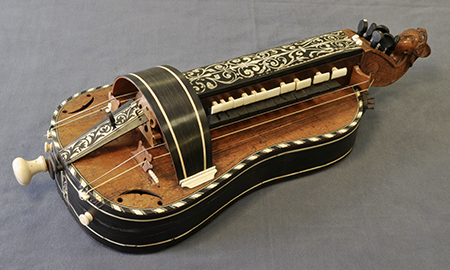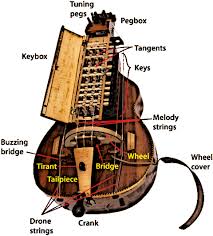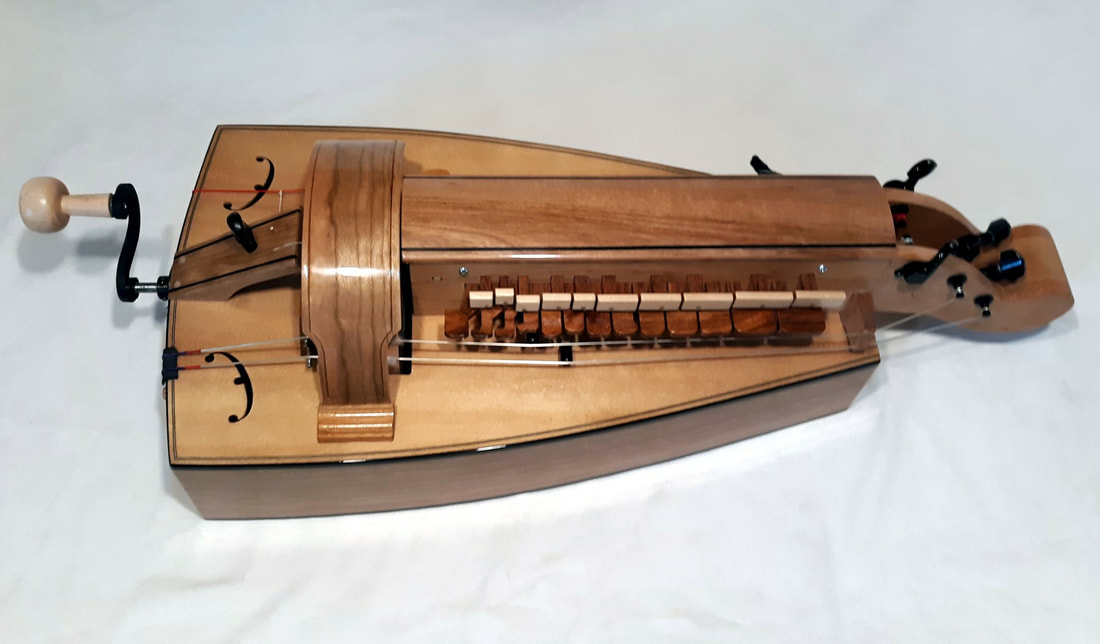It sounds like a medieval insult, disease or even sexual position, but it's a basic form of the stringed instrument played by turning a hand-crank wheel that rubs against the strings like a mechanised violin. The humpenscrump, a rough-and-ready version of the hurdy-gurdy, works in a similar way – melodies are played on a keyboard that presses tangents, essentially small wedges, typically made of wood, against one or more of the strings to change their pitch. It has a parallel with a previously profiled instrument, the Swedish nyckelharpa, except the latter's strings are played with a bow, not a wheel.
Hurdy-gurdy working parts
Medieval in origin indeed, the names are onomatopoeic, mimicking the repetitive warble in pitch from the warping of the wooden wheel, possibly due to changes in humidity or because of the sound of the instrument's buzzing-bridge. Alternatives are hirdy-girdy, or even hurly-burly, to express that unrefined sound, as well as the possible Hungarian hegedűs or Slovenian variant hrgadus meaning a fiddle. Other names include the French vielle à roue (wheel fiddle) or simply vielle, Dutch draailier, German name, Drehleier, and also Bauernleier, meaning "peasant's lyre". In Italy, it is called the ghironda or lira tedesca while in Spain, it is a zanfona.
The instrument was known to be used as early as the 10th century in Europe, primarily in monastic and church settings to accompany choral music. It is shown in the Pórtico da Gloria (Portal of Glory) on the cathedral at Santiago de Compostela, Galicia, Spain in the form of a a carving of two musicians playing what was then called the organistrum. In art, the first, and best known depiction of the hurdy-gurdy is a seemingly huge one, part of the hurly burly nightmarish vision of early Dutch master Hieronymus Bosch's The Garden of Earthly Delights, painted between 1490 and 1510. Listening to it must have felt a bit like hell, perhaps.
A hurdy-gurdy, or humpenscrump stands in Hieronymus Bosch's The Garden of Earthly Delights
The hurdy-gurdy became especially big in the Renaissance period, during which time that distinctive drone sound became popular, created by the buzzing bridge (also known as the dog), an asymmetrical wooden piece that rests under a drone string on the sound board. When the wheel is accelerated, one foot of the bridge lifts from the soundboard and vibrates. The instrument appears across the globe with a huge variety of shapes, mostly rounded like a lute, some more triangular or rhomboid. There different varieties of buzzing or non-buzzing bridges, from the German pear-shaped Drehleier, which is a string-adjusted version, to the wheel-adjusted tekerőlant (Hungary), or Austrian Tyrolian Drehleier, plus a range of non-buzzing bridges across eastern Europe, as well as electric and electronic versions.
An ornate Tyrolian model
There are many players, some of whom treat is as a novelty instrument, a sideline to guitar or violin, but others who are specialists in folk or other genres. The instrument is very popular in France, and so let's start with Patrick Bouffard, playing "Le dénicheur"
And here is more from French medieval specialist Valentin Clastrier:
The Pogues's Jem Finer is a multi-instrumentalist, playing banjo, guitar, mandolin, saxophone, but also the hurdy-gurdy on Misty Morning, Albert Bridge:
The instrument has also featured in several films. Here's Spencer Tracy as Manuel Fidello in the 1937's Captains Courageous:
Inspired by that particular film, British player Nigel Eaton here plays from his album Whirling Pope Joan
Eaton has also a been a collaborator with Jimmy Page and and Robert Plant on some of their post-Led Zeppelin project. Here they are doing the Blind Willie Johnson blues classic Nobody's Faujlt But Mine
Another rock guitar legend Ritchie Blackmore has experimented with the hurdy-gurdy. Here's some live footage of The Clock Ticks On:
Meanwhile, Weezer's Hang On includes the instrument played by Tony Berg:
It also appears in many other perhaps unlikely recordings, from Metallica's Low Man's Lyric from the 1997 album ReLoad, to Lou Reed's eccentric The Raven, inspired by Edgar Allan Poe. The wheel turns out many other examples.
More box-shaped version
Turning the wheel of memory, have you seen or heard other hurdy-gurdys or humprenscrumps being played or players across a range of music genres? Do any other types or images come to mind? Feel free to share other examples in songs, instrumentals, on albums, or other contexts in comments below. You can also get in touch the contact page, and also visit us on social media: Song Bar Twitter, Song Bar Facebook. Song Bar YouTube. and Song Bar Instagram. Please subscribe, follow and share.
New to comment? It is quick and easy. You just need to login to Disqus once. All is explained in About/FAQs ...





